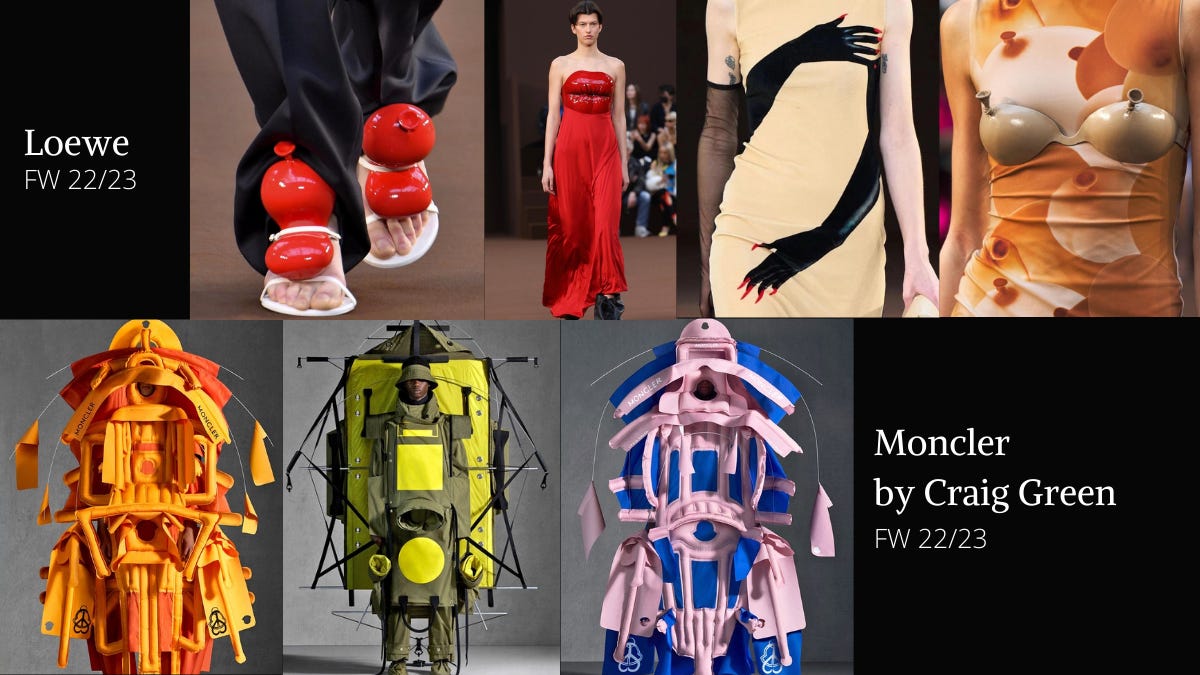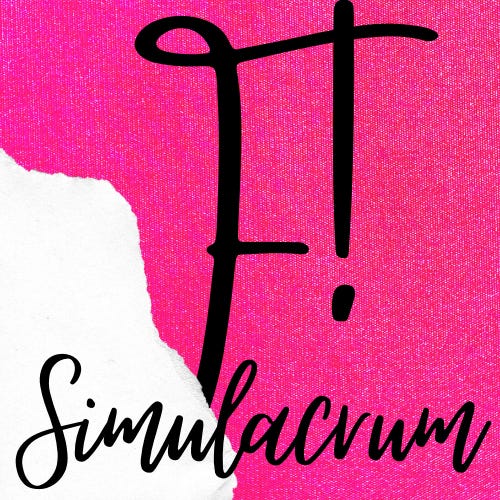In trend: Surrealism is the answer
To the nonsense, absurdity of latest events, to fear and expectation of new disasters, to uncertainty in the very language we speak to each other, in our own opinions, to our fragility and loneliness.
Image: Schiaparelly Haute Couture SS22
We used to talk about fashion as about business, industry, clothes and styles matters, even as about art. But we quite often forget that it’s also a projection of the cultural changes, movements, moods, even prevailing philosophies.
Now when marketing sucked the spirit of the great couturiers from the very process of the clothes creation, and when journalism in the area shrinked to descriptive essays, fashion still remains the mirror of the time. The time as we see it, as we feel it. So it looks like what we see is a fake.
In dangerous and aggressive periods of human history, when even in the most civilised and calm places people felt fear and desire to hide, to find a shelter, at least for their soul, if not for their body, the magic mentality, fantastic projections as well as obsession with popular science were always at their disposal for building hope. That’s how surrealism was born in 1910-1920s, and then bloomed in 1950-1970s. It gave a ground for multiple artistic styles, but all of them were connected by the first impression of primal surprise and recognition in the absurdity of the scenes, particular seeds of truth, a real connection to personal experience.
But postmodernism and consumerism cut the original sense of such art and left us with their sterile commercial versions. Now entertainment comes first, the name recognition, the price, the reputation are second, the sense is the last to look into. Fashion became an art at some point, then was reduced to the pop-art then to the commercial investment, and now it’s stuck in the vacuum of permanent repetition of the past - distant or as close as yesterday.
And the thing is you don’t even need to take an artistic method and fuse it into the garment design to see it. The whole industry around fashion weeks, shows, communication to the press, fashionistas, influencers, - to the public around them - is drowning in nonsense and sur-reality. No one knows what is good, what is not. What is about fashion, what is sport, what is homewear, what is about cultural expropriations, what is fake, what is authentic, where’s idea stealing and where’s inspiration, where’s story behind and where’s just a mythology written by a skillful copywriter. But most importantly no one can tell anymore: What is all that huge industry and hype around it for?
The closer you are to the centre of that whirpool, the less you feel it as something artificial. But people from a distance can’t understand a thing. The crack between them is huge. The bridge is the art inspired circle, people who can read the symbols and associations, appreciate the style and adapt the garments to their own tastes. And all that thanks to the fantasy, to the sense of personal identity. And their vision. Again not real, not objective, but personal reality. Another nonsense for everyone but one person. Surreal vision is the only true one for the actual consumer.
If you walk the streets of a huge metropolis you can see how that decision works - 80-90% of the people will be dressed “normally” - casual, sportive, business style - and only 10-20% will give a reason to look closer at their clothes or accessories. The fashion weeks produce the same results. There are few to look for ideas, many brands that copy-paste the common styles, and a bit more than a few show helpless attempts to be creative with copy-pasting avantgarde cuts or producing wearable sculptures. It looks like the latest trend is to make the surreal art wearable at least during the shows.
After the COVID, after the time of permanent search for anyhow surprising ideas, that will be socially or ethically vital for the marketing purposes, surrealism as a method became a helpful tool for the designers. After the deconstruction, after the pop-art, op-art, futurism, all the enthusiasm of the 90-2000s to dig something incredible out the museum collections and cut it to the new rebel couture, plain surrealism is back to trends.
With Schiaparelli exaggerated accessories, with Loewe weirdness, with functional absurdity of Craig Green for Moncler, with deconstructive anime-post-punk-sublimation of Noir Kei Ninomiya, Balenciaga’s kitsch consumerism, Anrealage spacemen camouflage and so on to the open artistic and fashion citations of the youngest designers like Harris Reed - with all that we slide into contemporary art gallery situation. When you are advised to like something by the gallerist, no need to understand what is exactly in front of you - a pile of junk food or a monument to the fast food society. I don’t mention the graduation parades from fashion schools, those are all about sur-reality. Or the Euphoria costumes and makeup that are definitely inspired not by the usual school community, but became a trend for the fans of the TV-show.
What are the reasons for such a massive run from normality, objective and crowd vision? Why is it so popular and overwhelming? The answer is the mentality of the digital generation. Social media introduced that sense of distance that was never in use before. I talk about the mental and psychological distance, and the borders of personal identity.
Travel with bytes and bits of information costs us nothing compared to the prices for the air tickets, hotels and cars, but everything if we consider the way we feel, think and see ourselves. Scrolling posts and messages on smartphones, talking to our friends by short messages or by visuals, we leave little of ourselves and each of the others interpret the rest. That means they add their own mood, experience and knowledge, but those are numerous and they never unite or correlate to our true meanings and intentions.
Our inner reality will interact with theirs. If the result is negative we learn to control ourselves, so not to upset anyone, including ourselves. From such storages of adaptations walls are built and borders between us become so high that sometimes we don’t see further than the view from the window. We feel trapped in our lives like we never felt before though the world is open for us - virtually and physically. The only way out is to build our own world inside. Not the inner world filled with traumas and joys, instincts, memories, emotions, but a full parallel reality with pictures and visuals of places and people we’ve never met, with our own moral codes, idealistic conceptions, rules and laws, with maximalism and very sensitive sense of absolute rightness.
As soon as it meets reality, the amount of different visions and opinions cause collusions and stress. Aggression seems unbearable. Though it’s not a real aggression. It’s what the teenagers receive from their parents and adults - an experience, based on personal knowledge and beliefs of other people. It takes time to get used to it and to see it as an opportunity to grow.
But we are not teenagers, we don’t feel the need to adapt. We think we know better. That our illusion, our reality is better. So we stay as we are. In the same cells of our minds. And the aim is to make our surreal vision interesting and satisfying enough, keeping it safe and protected from the outer world reality. And to see all the rest as something distant, when it’s unfair and difficult then it’s also dangerously wrong, unacceptable. No matter the fact that those are processes that were there forever. For us they are news, because they hit us suddenly in the face - from the screens of our phones.
Is it a comfortable and effective way to exist and deal with life? Yes. Does it provoke laziness of the mind and psychological fragility, a need to belong to the community that doesn’t exist? Also yes.
And if we completely move in to the metaverse world (fashion is already there) do you think it’s the direction we should evolve?
P.S. It should have been paid article, but as far as you, my dear subscribers, don’t know me as a journalist and a writer, I will leave it for free access. Don’t hesitate to leave your comments. I really appreciate your point of view.
My platforms
Instagram: https://www.instagram.com/zakharova_kaetano
Twitter: https://twitter.com/olga_kaetano
Telegram: https://t.me/f_simulacrum
Tumblr: https://fashionistaru.tumblr.com
If you like F! Simulacrum and want to help make it even better, give me feedback, point out factual errors or typos, or send me news subjects you want to describe. My email: o.zakharova@adlifestudio.ru
Substack says I have exciting news to share with you: You can now read my F! Simulacrum in the new Substack app for iPhone.
With the app, you’ll have a dedicated Inbox for my Substack and any others you subscribe to. New posts will never get lost in your email filters, or stuck in spam. Longer posts will never cut-off by your email app. Comments and rich media will all work seamlessly. Overall, it’s a big upgrade to the reading experience.
The Substack app is currently available for iOS. If you don’t have an Apple device, that sucks (for me:))) you can join the Android waitlist here.








